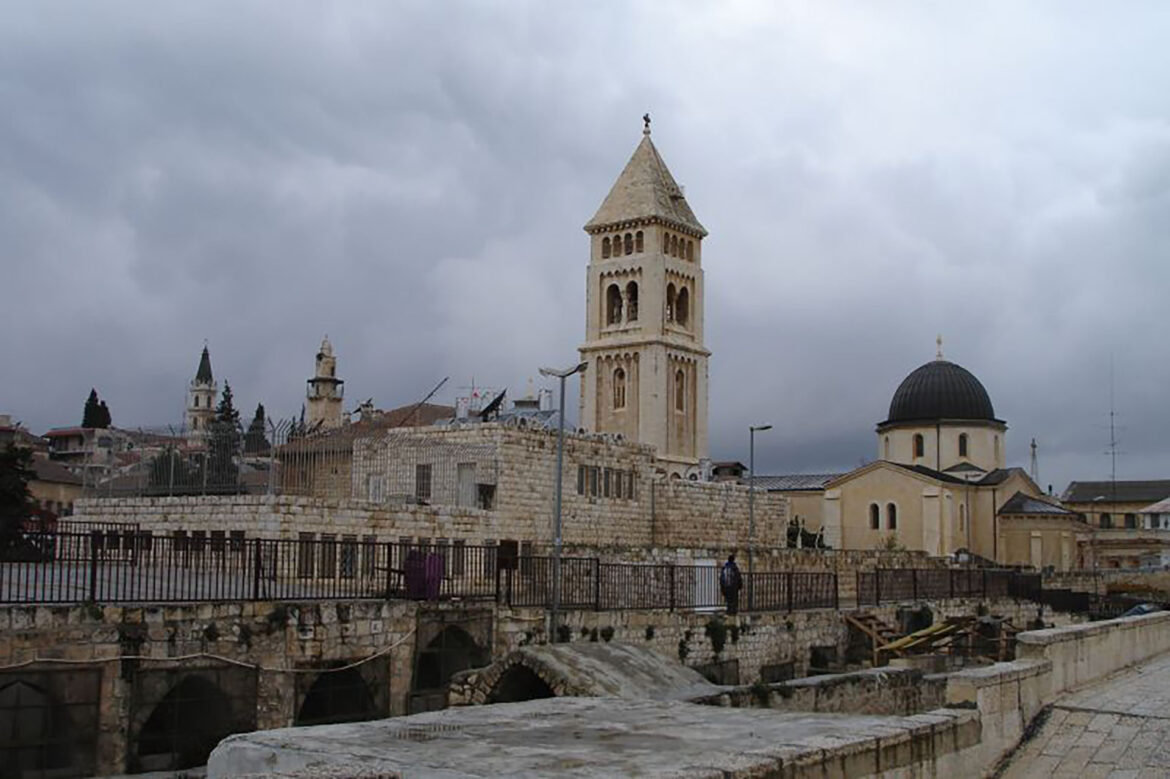Bimaristan Al-Salahi is located in the Old City of Jerusalem. Sources differed as to whether its history dates back to the Fatimid or Ayyubid era, and it provided health care to Jerusalemites and visitors to the city of Jerusalem.
Bimaristan is a word of Persian origin composed of two syllables: “bimar” meaning sick, and “stan” meaning a place or house. Terminologically, bimaristan is defined as the place where patients are treated under the supervision of specialized doctors, and provides integrated medical services that include medicine, food, and water, in addition to auxiliary tools and services. .
the site
The Salahi Bimaristan is located on the southern side of the Church of the Holy Sepulcher in the Old City of Jerusalem.
Founding and history
Sources differed regarding the date of the establishment of Al-Bimaristan Al-Salahi, as some accounts indicate that its establishment was during the reign of Saladin Al-Ayyubi after the conquest of the city of Jerusalem in 1187 AD.
It was stated in Ahmed Issa’s book “The History of Bimaristans in Islam” that Sultan Saladin, upon his conquest of Jerusalem, ordered the church adjacent to the Aseptar House to be transformed into a bimaristan for the sick.
Saladin also endowed the Bimaristan in various places and provided him with abundant medicines and drugs. Judge Bahaa al-Din authorized Yusuf bin Rafi’ bin Shaddad, who was known as Ibn Shaddad after his maternal grandfather, to supervise the endowments allocated to the Bimaristan thanks to his knowledge and competence.
On the other hand, other sources report that the Bimaristan existed during the Fatimid era, and that Saladin rebuilt and developed it after that.
Mujir al-Din al-Hanbali stated in his book “The Great Man in the History of Jerusalem and Hebron” that “The Salahi Bimaristan had existed since the Fatimid era, and part of it was destroyed, so King Saladin ordered the restoration and rebuilding of what was destroyed.”
According to the sources, the site was an old church, and when it was demolished, a small hospital was built in its place, which expanded during the Crusader period and became a center for the Knights of St. John, the order founded by Father Jarrar, which was known to the Arabs as “Hospitalians,” due to their reputation for treating sick Crusader knights.
After Saladin liberated Jerusalem, the hospital remained in existence, and became known as “Bimaristan al-Salahi,” and continued into subsequent eras.
The Bimaristan al-Salahi in Jerusalem continued to provide medical services during the period of the first Ottoman Empire (1516-1831 AD) to Jerusalemites and visitors. At the end of the 18th century AD, it stopped working.
In 1868, Sultan Abdulaziz presented the eastern part of this region to Crown Prince Frederick William of Prussia during his visit to Jerusalem. The prince was at that time the head of the Knights of Gunantorden, the Protestant heirs of a former branch of the Hospitallers.
The German knights created a road passing through Bimaristan from north to south, and they called it “Prince Frederick William Street,” and the property became a center for the German community in Jerusalem.
Organization and structuring
According to the mechanism followed in Bimaristan, the recruitment of doctors was carried out only upon the order of the Ottoman Sultan, and the chief physician was responsible for appointing doctors and pharmacists and granting them the right to practice the profession.
Among those who held the position of chief physician was Sheikh Shams al-Din Muhammad ibn Zain al-Din, who received a wage of 3 aqjat per day, as well as Muhammad ibn Ahmad, who assumed this position in Bimaristan in 1595 AD.
The bimaristan consisted of a group of stone pillars topped by arches, and its area was divided into a number of halls covered with cross-vaulted ceilings and barrel ceilings. Each of these halls was dedicated to treating different diseases.

The properties assigned to the Bimaristan varied between houses, shops, tanneries, oil khans, Qabbana, bakeries, agricultural lands, and others.
Among the most prominent doctors who worked in Bimaristan: Yaqoub bin Saqlab al-Nasrani, originally from Balqa. He was born in the city of Jerusalem and learned medicine there. Then he joined to work in Bimaristan al-Salahi, and remained there until the Most Reverend Issa Ibn al-Adil transferred him to Damascus to work in Bimaristan.
Among them is also Rashid al-Din al-Suri, who is the son of al-Mansur ibn Abi al-Fadl. He was born in the city of Tyre. He had extensive knowledge of medicines and the medical industry. He was one of the most prominent people who read Galen’s books in his time. He resided in Jerusalem for many years and worked in Bimaristan, then King al-Adil transferred him to Egypt and later served under Al-Muazzam Issa.
Specializations and achievements
In general, the Bimaristans provided the population with various social and medical services, including free treatment, especially for the weak and poor. They were also a shelter for orphans and infirm women, and the dead were washed, shrouded, and shrouded in them, in addition to the public role that the Bimaristans had during the spread of epidemics, which was an essential factor for its establishment.
Over time, the bimaristans developed from being institutions that provided health and treatment services to institutions that provided sums of money to patients and clothes upon their discharge, so that they would not have to work throughout the recovery period, and they also contributed to the spread of medical science.
Regarding the Salahi Bimaristan, it was divided into several specialized departments to cope with various types of diseases. It included a general medicine department in which surgical operations were performed, an eye surgery department, and a hall for isolating the insane.



